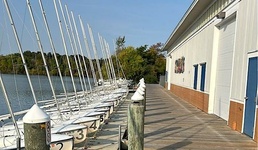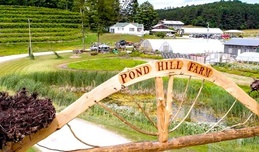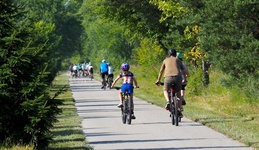Grand Traverse Commons
June 13, 2007
The Village at Grand Traverse Commonsoffers stunning architecture and unique shops
With his trademark white hard hat, Ray Minervini II is standing on a porch of the sprawling grounds of Grand Traverse Commons, the site of a former asylum located minutes away from downtown Traverse City.
He is looking west toward the woods and some might say hallucinating. Most people see scrubby grass and a tired, empty road. Minervini sees a piazza modeled after the romantic courtyards of Italy — a glorious fountain surrounded by a wide sidewalk with park benches. In the winter, there’ll be a skating rink.
Minervini knows exactly what it will take to bring the vision to reality. For the last five years, he has quietly morphed several of the deteriorating buildings that are set amid 400 acres of beautiful woodland and trees.
Articles here and there have announced the latest business venture. But now the massive redevelopment project on this 64-acre campus is hitting critical mass. This summer will see the opening of dozens of new businesses, offices and retail stores, adding to the dozens that are already here—including attorneys’ offices, a coffee shop, a popular and ever-expanding yoga studio, medical offices, two massage therapists, a chapel, and Northern Express! Eighteen condos are sold, and more than 40 will be completed by year-end.
NEW MERCATO
The Mercato (Italian for “market”), a garden-level marketplace, will likely get the most public attention. It has just opened in a broad, sunny hallway of Building 50, the 400,000 square-foot focal point of the Grand Traverse Commons.
The shop line-up, so far, includes the Silver Tree Deli, an equestrian shop (the only one in Northern Michigan), a custom dress designer, Premier Floral Designs, Salone de Capelli (a hair salon), and Gallery Fifty, which is now featuring the work of artist Rufus Snoddy.
The tinier buildings are filling up too. The Pleasanton Brick Oven Bakery is opening in the old firehouse. Boasting a unique wood-fired brick oven, it will open in mid-July and sell naturally leavened bread, baked goods and maybe deli items.
Two new businesses are going into the old laundry building — the Higher Grounds Trading Company with a roastery, tasting room, coffee bar, and even bike delivery in the downtown area.
There’s also Left Foot Charlie, an “urban winery” complete with a wine tasting room. A former laundry building, the winery takes advantage of sky-high ceilings and natural light from a long bank of windows. Bryan Ulbrich, the owner, believes that grapes from each of the local vineyards has a characteristic taste. So he’ll batch and ferment grapes from each source vineyard and label them separately.
NEW HOTEL
One of the most ambitious upcoming projects is a “boutique” hotel, complete with 84 rooms, a meeting room, a restaurant, and a banquet facility. Minervini will renovate the two former cottages for male patients, which were connected by a dining hall. The $20 million project will total 95,000 square feet and start in the fall or early next year.
No matter what building we hit on a tour of the campus, there are workers drilling, sweeping, and digging. Yet the Commons is still off the radar of many folks, and in desperate need of better signage. But here’s a prediction for what’s it’s worth: The Village at Grand Traverse Commons will attract locals and tourists alike and give Traverse City a totally different feel, reminiscent of old world Italy.
LOOKING BACK
Back in 1989 when the Traverse City State Hospital first closed, there were clusters of patients who gathered at picnic tables near Building 50 — the largest building on campus. For months you could see them smoking and talking, and then one day, they drifted away.
The asylum opened in 1895, built with yellow bricks made from the clay of nearby Cedar Lake. Based on the theory that “beauty is therapy,” patients were mostly treated with compassion and each was given a private room. The campus was like a biological hothouse planted with more than 100 types of trees, including world champions.
There are varying views of institutional care now (some people looked at the private rooms as tiny cells), but the vision then was that the blend of nature, therapy and hard work on the self-sustaining campus would soothe the patients’ tormented minds. The hospital once operated like a thriving small town--a time before laws banned patient labor and medication breakthroughs dropped the patient census.
Ray and his wife, Marsha Minervini, moved up to Northern Michigan in 1989, the year the state hospital closed in 1989. They were expecting to take it easy, but that all changed when they heard about the possible demolition of the historic buildings at the Grand Traverse Commons. Ray and Marsha had years of experience in construction, but Ray wasn’t sure he was the man to do it.
After all, it involved an unheard amount of space — 700,000 square feet, involving six-foot brick walls, removing asbestos and lead paint, and struggling with the arcane rules of historic preservation. He worked on a plan for a year, but decided he still needed to bounce it off his dad, who had died two years before.
“I thought, ‘I’ll go talk to my dad at the cemetery.’ And that’s what I did. I asked him, ‘Is this something I can do?’ He said, ‘Yes you can. You can do it.’ He said, ‘Put art on the walls and music in the halls and people will come.”
Ray’s father, Rinaldo, spent a career in construction, but began painting in earnest after he retired at the age of 63. “He had an absolute passion for his art,” said Minervini, who displays his father’s paintings on the 14-foot-high walls of his office.
NEW SHINGLES
The new Mercato with its broad hallway and natural sunlight will also serve as a perpetual art gallery, featuring the best of regional artists.
With approval from his dad, Minervini’s first order of business was to save the buildings from any further deterioration with new roofs. “Some people say I make so much money because I got the property for $1, but what they don’t realize is it wasn’t for nothing. I immediately invested one and a half million dollars out of my own pocket to put new shingles on the roofs,” he said.
Minervini has relied on state and federal redevelopment grants for asbestos and lead paint removal and environmental work. He also had to figure his way around the multi-layer maze of building approvals—a process that he still sees as a challenge. And he and Marsha also approached this as a family. Marsha handles the real estate sales. Ray’s sister, Mini, recruits tenants for the office space, condos. And their four sons work in various aspects of the business.
BRINGING IT ALL TOGETHER
Since the advent of malls and subdivisions, people have yearned for a sense of community. Minervini felt it growing up in Detroit (the home, ironically, of America’s first mall). He remembers walking to the market with his Italian grandma and shopping from the Polish, German, and Italian vendors. “I always thought the pirogie was Italian,” he joked. “Walking to the market was an easy thing to do. It worked great. Not everything is spread out. The typical subdivision creates an immunity to community.”
Inspired by the books, “The Geography of Nowhere” and “The Great, Good Place,” Minervini is committed to the idea of bringing the community together.
At The Village, shops go on the ground floor, offices on the second floor, and condos on the upper floors. Minervini also mixes up the rich and not so rich. The condos at The Village are priced anywhere from $50,000 for a studio up to $600,000 — and they’re right next to each other. There’s no doubt you would get more space for the money if you bought a traditional house, but you’re also buying “all this,” said Ray, sweeping his hand toward the wooded campus.
Businesses and residents also get a significant tax break under a 15-year renaissance zone agreement with the State. They pay virtually no Michigan property taxes, no single business tax, and may even get tax credits for historical renovation work. For a $300,000 condo, for example, the property tax savings alone are worth about $5,000 per year.
ONE BITE AT A TIME
Ray’s philosophy is to develop the campus “one bite at a time.” Everything that is built is sold or leased. In Ray’s mind, there’s enough business to go around if you take it slow. There’s already talk about whether The Village will drain business away from Front Street. The downtown farmer’s market will compete this summer with the farmer’s market at the Commons. Called TGIF, Thank Goodness It’s Fresh Farmer’s Market, the market will be held, naturally, every Friday from 3 p.m. to 7 p.m. Starting June 26, it will also be open on Tuesdays, 3 p.m. to 7 p.m.
The cost to a vendor is very low — only $10 — which will go toward signage and promotion.
Ray trusts that the downtown and The Village will work synergistically.
“I was at a DDA (Downtown Development Authority) meeting and a market study talked about the ‘challenge’ of the Commons,” Minervini said. “I said, first of all, I don’t think the Commons is a challenge. The kind of people who want to spend downtown will spend their time here, as well.”
But to make it work, the Village and the downtown will have to build connectivity, including sidewalks, bus routes, and improved pedestrian crossings across busy Division Street.
It’s all in a day’s work for Ray. He has boundless energy, a perpetual smile on his face, and his supervisors and workers talk easily with him. In a sense, he has carried on the tradition that the state hospital began more than 100 years ago: treating every person you brush up against with respect and compassion.
“I rarely get upset. It doesn’t do much good. I think you get better results if you treat people humanely.”
New Openings at the Village
Mercato Marketplace
Building 50
A broad, sunny hall of shops that connects the south side of Building 50 to Another Cuppa Joe.
Salone de Cepelli (opens
in mid-July)
Premier Floral Designs (open)
Gallery Fifty (open)
Red Hare Tack and Togs (Northern Michigan’s only equestrian shop (opens early July)
Jeannette Veeder Designs (custom dress designer, just opened)
Artist Rufus Snoddy is displaying his art in the sunny, broad hallway of the Marketplace
Left Foot Charlie
Building 53
Fermenting and bottling wines from local fruit. Features sales and tasting room. (Opens in early July)
Pleasanton Brick Oven Bakery
Building 66
Nestled in the former brick firehouse, the bakery will sell naturally leavened bread from its wood-fired stove and other baked goods (opens mid-July).
Higher Grounds Tasting Company Building 53
Roasts and serves organic coffee that is purchased as “fair trade,” meaning growers in Third World countries get a fair price. Features a tasting room and bike delivery. (Opens in mid-July)
Underground Cheesecake
Building 67 and 69
Serves cheesecake, deli items, and coffee. Will bake and make the goods in the long building right behind the retail shop (opens in the fall).
Boutique Hotel
Buildings 22, 28 and 40
Includes 84 rooms, a meeting facility, a restaurant, and a banquet facility. The $20 million project will involve 95,000 square feet and start in the fall or early next year with completion slated for 2008.
Thank Goodness It’s Fresh
Farmer’s Market
Front lawn of South Cottages
off Silver Drive
The market opened in late May and will be held every Friday from 3p.m. to 7p.m. Starting June 26, it will also open on Tuesdays from 3p.m. to 7 p.m.
Trending

Three Days of Art in Cadillac
The Cadillac Festival of the Arts kicks off on Thursday, July 17, with the Up North Arts Color Fun Run at 6pm at City Dock. … Read More >>
Adaptive Sailing
For this Beaches, Boats, & BBQ issue, we wanted to give a shoutout to Traverse Area Community Sailing (TACS) and their f… Read More >>
Pond Hill Turns 30!
Pond Hill Farm does a little bit of everything. It’s a brewery and a winery. A cafe and a market. A pizza joint and a … Read More >>


